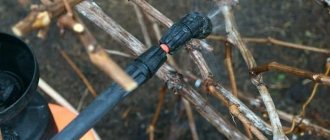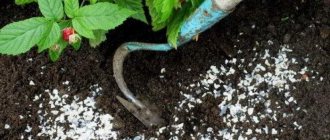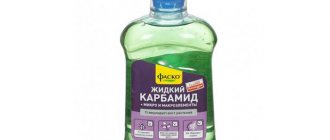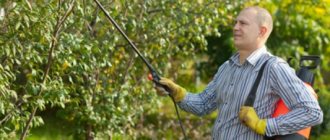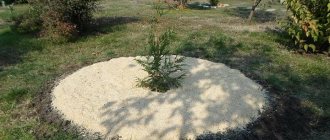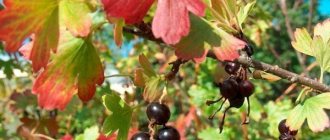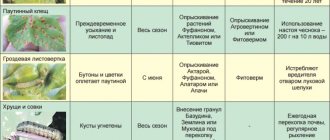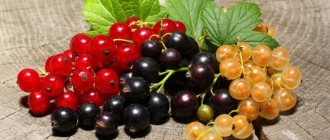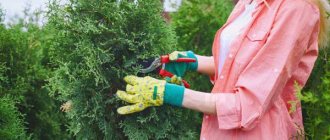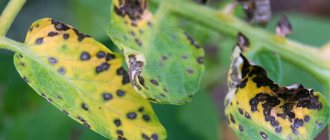How to treat apple trees
Proper autumn treatment will help the tree to withstand winter frosts well. But there are a number of procedures that need to be carried out immediately before spraying with various preparations.
At what temperature
Trees should be treated in autumn in dry and windless weather, at above-zero temperatures. It is possible to spray after the first frost, but only when the weather is warm during the day. It is better to choose a time when there is no rain, so as not to spoil the whole effect.
How to keep trees from frost
Whitewashing the trunk and base and even parts of the skeletal branches will help protect plants from frost, pests and diseases. To do this, use a mixture of lime and clay, adding a little copper sulfate. Some people prefer to purchase a ready-made mixture.
If the cortex is damaged
The apple trees are inspected. Having found damage on the trunk, they clean it, and if the bark is injured, then it is cut off. Wounds are disinfected with a 1% solution of copper sulfate, dried and lubricated with garden varnish. Depending on the scale of the problem, cleaning is carried out with a special soft spatula until it is alive.
Proper treatment of apple trees in the fall from pests and diseases
Frosts and sudden changes in temperature become the culprits of various cracks in the bark and frost holes. And this is a gateway to infection and dangerous deformation of the tree bark.
For protection, it is necessary to carry out a number of actions in the fall , including spraying, fertilizing, and whitewashing the trunks.
If you start spraying too early, you can quickly cause damage without achieving the desired effect, and the apple trees will remain unprotected.
They begin processing apple trees in the fall, when 50% - 70% of the leaves have fallen, the fruits have already been collected , and after the leaves have completely fallen, the solution is made even stronger.
In October, it is good to whitewash tree trunks , and in November, spray them with the necessary substances.
How to treat apple trees after harvest
If necessary, preventive spraying can be carried out throughout the season. But you need to approach concentration wisely. If at the beginning of the season certain drugs can harm beneficial insects or spoil the harvest, then in the fall you can treat with the drugs in the required concentration.
From scab
The fight against scab begins in early spring with preventive spraying, and in case of infection in the summer, it is necessary to treat all the trees in the garden at the same time. Spraying of apple trees in the fall is carried out after leaf fall, and solutions of higher concentration can be used. For treatment, the modern drug Oksikhom is used; Bordeaux mixture, iron sulfate and colloidal sulfur solution are also successfully used.
Scab on an apple tree.
From fruit rot
Moniliosis, or fruit rot, is a fungal disease that affects branches and fruits. In the fall, branches, leaves and fruits affected by the disease are removed, the garbage is burned, and the tree is treated with cuproxate and copper sulfate to destroy the remaining infection. In the spring you will need to inspect the apple tree again and carry out preventative spraying.
This is what fruit rot looks like.
From lichen
In late autumn, when the harvest is harvested and the leaves are burned, the apple tree is sprayed with a 5% solution of iron sulfate. In a week, all the lichens will dry out and fall off. They need to be collected and burned, and the soil under the tree should be treated with the same solution as the plant. There is another recipe. Prepare a putty of mullein, clay and vitriol, apply thickly to the lichen. Complete the cleaning process by whitewashing the trunk and skeletal branches.
If you do not treat the apple tree in time, lichen may appear on it.
From rodents
To protect the garden from hares, sharp-smelling substances are used, which are added to whitewash or mulch, which is scattered around the tree. You can make a composition of mullein, clay, and creolin and coat the trunk.
Bark damaged by rodents.
Experienced gardeners also advise protecting with a chain-link mesh, plastic bottles, roofing felt, and wrapping the trunk.
For mice, it is recommended to deepen barriers around the trunk into the soil by 10-15 cm, as they make holes. You can mulch around the trunk with sawdust soaked in a solution of carbolic acid or creolin, scatter dry coriander flowers.
From worms
The infestation of fruits by worms indicates the presence of codling moths. Its caterpillars hide in the dead layer of bark, which must be cleaned and destroyed. Paint the trunk and skeletal branches with special garden paint. The treatment must be done before the onset of frost.
Apple codling moth larva.
From fungus
If a cytosporosis lesion is detected, areas of the bark are cleared, the branches are cut and burned, and the wounds are sprayed with a fungicide after treatment. Preventive measures and protecting the plant from burns, mechanical damage and whitewashing of the trunk and branches will not allow the fungus to penetrate the cambium. If this happens, the tree will gradually die.
Cytosporosis on an apple tree.
From aphids
The aphid lays eggs in root shoots, and there they overwinter; the affected shoots are cut out and destroyed. Nearby anthills must be removed, as ants carry aphid eggs.
Signs of aphids on an apple tree.
In autumn, trees are fumigated with sulfur bombs.
From ticks
Apple trees are affected by spider mites, which overwinter in fallen leaves. Therefore, in the fall, the garden must be cleaned and burned everything that could be a source of pest infestation. Then only preventive spraying will help.
Magnified photo of a spider mite.
From black cancer
The affected areas are cleaned, the branches are removed, after cleaning they are treated with a 1% solution of copper sulfate or 3% iron sulfate, dried and applied with garden putty. The hollows on the trunk also need to be processed and sealed.
This is what black cancer looks like.
From silkworm and bark beetle
Damage to the apple tree is caused by oak silkworm caterpillars, which overwinter in the old bark and cracks. The trees are inspected and, if found, parasites are collected and destroyed.
Settlement of silkworms on an apple tree.
The bark beetle causes great damage to the garden and is difficult to control. The passages in the bark must be pierced with wire to kill the beetle and an insecticide must be injected into the hole. If an apple tree is severely damaged by a pest, in order to prevent damage to other plants, it is better to destroy it.
Apple tree cut processing
After autumn pruning, the cut sites are lubricated with garden varnish so that the tree does not lose sap. If it rains, the treatment will need to be reapplied.
Treating a cut tree with garden varnish.
Processing frostbitten wood
The bark of an apple tree may be damaged by severe frost; cracks and tears may form on it, which need to be cleaned and disinfected. The frostbitten part of the branch must be cut off and treated with a solution of copper sulfate. Lubricate all cuts with warm garden varnish.
Processing frostbitten wood.
The wound can be wrapped in a piece of natural fabric and a nutritious mixture of mullein and red clay placed on top of it.
A set of measures for autumn care of apple trees
Autumn care for apple trees should be comprehensive and include
- cleaning leaves and carrion;
- barrel cleaning;
- pruning;
- whitewash;
- spraying;
- strapping with insulating materials.
All the numerous procedures for preparing apple trees for winter will help keep the trees healthy and strong and get a good harvest next season
Types of drugs and dosage
To treat plants, you need to select those drugs that will successfully fight diseases and pests, and follow the dosage according to the instructions.
inkstone
This drug is used to control pests (including those hibernating under the bark of trees). To remove mosses and lichens, make a solution of 500 g / 10 l of water, against fungal diseases - 30 g / 10 l of water. For treating hollows – 100 g / 10 l of water. Trees are generously sprayed with the drug.
Ready-made solution of iron sulfate.
Copper sulfate
A 1% solution (100 g/liter) is used to treat viral and fungal diseases, the entire tree is treated, a 3% solution (300 g/liter) is used against harmful insects that attack roots and wounds on the trunk.
Copper sulfate powder.
Urea urea
A concentrated solution of urea, 500-700 g / 10 l of water, is used after leaf fall; the entire tree, the soil under it and fallen leaves are treated with small drops. Treatment at an earlier time may cause burns on the plant.
This is what Urea urea looks like.
Bordeaux mixture
This mixture consists of 300 g of copper sulfate and 400 g of lime, which is diluted in water. The mixture is prepared as follows: vitriol is diluted in 5 liters of water and lime in 5 liters of water, both solutions are combined by pouring copper sulfate in a thin stream into the lime mortar.
Fitosporin
Phytosporin is used to protect plants from bacterial and fungal diseases. The solution is used to treat the soil under the tree and fallen leaves. It is also a good organic fertilizer.
The drug Fitosporin.
Karbofos
The drug protects apple trees from mites and other pests, but only affects adults. Trees are treated 2 times per season. In the fall, you can apply the treatment a month before harvest or a month later.
Karbofos in various dosages.
Lime
Whitewashing in the fall is carried out only after cleaning and disinfection, with slaked lime or a solution with the addition of copper or iron sulfate.
Whitewashing with lime.
Preparation of the mixture: in a bucket of water, dilute 2-2.5 kg of lime, 300 g of copper or iron sulfate, 1 kg of clay, 250 ml of acrylic paint and 150 g of casein glue. The trunk and skeletal eyelids are whitened by 1.5-1.7 meters.
Salt treatment
A solution of table salt 1 kg per 10 liters of water is used to protect apple trees from diseases and pests, spray the plant after the leaves fall. After this treatment, the trunk is cleared of mosses and lichens.
Preparation of saline solution in small doses.
Using salt, a mixture is used to whiten trunks; it is prepared from the following ingredients:
- table salt – 1 kg;
- wood ash – 2 kg;
- laundry soap, grated – 2 pieces.
Pour hot water over everything and bring to a boil, cool the mixture and lubricate the trunks of apple trees
Composition of the scab mixture
To combat scab, use a mixture of 400 grams of copper sulfate and 300 grams of lime, diluted in 20 liters of water.
A solution of colloidal sulfur, Bordeaux mixture, and urea are used.
Fungicides and chemicals
Various preparations are used to treat apple trees. Correct use and dosage is important.
Contact:
- copper oxychloride;
- karbofos;
- Bordeaux mixture;
- sulfur;
- carbamide (urea);
- inkstone.
Systemic drugs:
- Strobe;
- Speed;
- Horus;
- Oksikhom;
- Fundazol;
- salt;
- slaked lime;
- Fitosporin;
- biological products: Gauxin, Bitoxibacillin.
Timely examination and identification of the disease, as well as treatment with a properly selected drug will give a good result.
Scheme for processing apple trees from spring to autumn
| Early spring before the buds swell. | spraying iron sulfate (5% solution)
| |
Spring (late March-April)
|
|
|
| Treatment with Aktara (50-60 ml per 10 ml of water) and Skor (1.5 g per 10 liters of water). | |
| Summer (June) | From codling moth and spotting. | Actofit (50-60 ml per 10 liters of water) or a composition of: Lepidocide, Gaupsin, Bitoxibacillin (repeat biological treatments after 10 days). |
Autumn
| Treatment of trees and soil, fallen leaves with 3% Bordeaux mixture or 5-7% urea solution. |
How is autumn whitewashing carried out?
Whitewashing trees helps destroy pests and saves you from burns. The older the tree, the more it needs to be whitened. Whitewashing can slow down the progression of bark diseases.
It is most effective to use a simple aqueous solution of chalk or slaked lime mixed with copper sulfate. You can supplement the mixture with laundry soap, clay or horse manure. This mixture is more reliable. It is necessary to carry out whitewashing at the last stage after other treatments. The trunk of the apple tree is treated with the prepared solution to a height of about 150 cm, so that the skeletal branches are also captured. The concentration of the product should be no more than 20%.
Diseases of apple trees with curled leaves (with photo)
There are diseases of apple trees with curled leaves that need to be recognized as soon as possible, since they pose a danger to other garden crops. Familiarize yourself with such diseases of apple tree leaves in the descriptions further on the page: this will allow you to quickly recognize the signs of their occurrence.
Pestalocia spot of apple tree.
The causative agent is the fungus Pestalotia malorum Elenk. et OM . The spots on the leaves are grayish-brown, round, merging. Over time, numerous black sporulation pads form on the necrotic tissue. Affected leaves turn brown and dry out prematurely. The infection persists in the affected fallen leaves.
Control measures. Spraying trees in the spring, before flowering and immediately after it, with 1% Bordeaux mixture or its substitutes (HOM, Abiga Peak), collecting and burning fallen leaves.
Tobacco necrosis virus on apple trees.
necrosis virus (TNV) manifests itself as a systemic necrotic reaction. Necrotic spots of irregular shape appear on the leaves, which become concentrated, necrotic, the veins darken, and the leaves die prematurely. Leaf deformation, plant dwarfism, and lack of flowering may occur. The virus affects vegetable, industrial, fruit and berry, flower and ornamental crops. The range of host plants includes representatives of more than 40 families. Transmitted by plant sap and zoospores of Olphidium brassicae.
Control measures. Use of healthy planting material, compliance with all requirements of agricultural technology for growing crops. Timely pruning of leaves and branches with symptoms of viral infection, removal and burning of heavily affected young trees. Disinfection of garden tools (knives, secateurs) in alcohol, cologne, 1% solution of potassium permanganate after working with affected plants.
Look at these diseases of apple tree leaves in the photo, which shows all the signs at different stages of damage:
Preparing pears for autumn processing
Before you begin to fight rust or scab on a pear in the fall, carry out thorough preparation.
- Cut off all damaged branches;
- Clean the trunk of all kinds of growths, swellings, and flaking bark. It is advisable to cover the root circle with film or tarpaulin to prevent fungal spores from getting into the ground.
- Remove the fruits remaining on the tree.
- Remove fallen leaves and cut shoots and burn them.
- The root circle is weeded out and dug up.
Only comprehensive control measures will help cope with rust and other fungal diseases on pears in the fall.
Recommendations for the use of drugs
To treat the garden, you need to use only approved products with an acceptable expiration date. When purchasing chemicals, you need to check the quality certificate. Treating the garden against pests and microorganisms in the fall is no different from treating apple trees against diseases and pests in the spring. Be sure to use personal protective equipment. You need to spray apple trees in the fall on a windless day.
It is necessary to try to process all the garden trees in one day. It is better to use a sprayer with good atomization. The solution is distributed more evenly, falling in small drops. It is necessary to ensure that the sprayer and filters are constantly cleaned and kept clean. You cannot work with drugs at subzero temperatures.
If there is any unused working solution left, do not throw it away. It’s better to find a useful use for it and use it the same day. All the preparations described above can be used to treat any fruit trees, flower and ornamental plants, and berry gardens. Perennial plants can be treated with urea against aphids.
Radical chemistry
Supporters of achieving 100% quick results prefer the use of insecticidal preparations. In this case, you need to know how to treat apple trees against aphids in the spring during different periods of the growing season.
- In the first month of spring, at an average air temperature of +5-+10°C, “bare” wood is treated with Karbofos, Oleocuprite, Nitrafen, Kemifos, etc. The dilution recipe for each drug is indicated in the instructions for use.
- In the interval between the blossoming buds and unblown inflorescences, you can save the apple tree with Ambush, Decis, Trichlorol, Phosfamide, Cyanox, etc.
- Insecticides are also used when re-treating the garden in the summer. You can use one of the organophosphorus agents Fufanon, Bi-58 new, Rogors.
Advice. Pest control measures by spraying are best used in calm and dry weather. The right time is morning or evening without active sun. The drug will have time to destroy the aphids and not evaporate.
How to get rid of aphids in the fall: prevention
Before you begin intensive treatment of garden plants, it is necessary to carry out a series of preventive measures that will help prevent the pest from appearing on your plants.
Preventive measures include putting things in order around plants, collecting and burning plant residues, loosening the soil, and removing weeds. All fallen fruits or those hanging on the shoots must be removed, and the same should be done with leaf litter.
Photo: Burning plant residues is a preventative measure.
After you put things in order, you need to give the bushes and trees a light haircut. In October, this is usually sanitary pruning, which involves removing dry, broken, too thin or thickening shoots. You can also remove twisted shoots that were damaged by insects in the summer. There may already be an infection at the tips of these shoots. All sections must be insulated with garden varnish.
After pruning, it is very advisable to feed the plants to increase their immunity.
| Now you cannot use nitrogen fertilizers; you should add superphosphate and potassium sulfate, a teaspoon for each bush and a couple of teaspoons for each tree. |
Apple tree bark diseases: what is the danger
Any diseases and wounds of the apple tree weaken the tree and its defense mechanisms, reducing the crop’s resistance to diseases and pest attacks. Mechanical wounds do not pose a particular threat to neighboring trees, but are an entry point for the attachment of an infectious agent.
Infectious diseases are dangerous due to the speed of spread and reproduction of pathogens . Fungal diseases spread very quickly with water and wind, can overwinter in the soil and require special attention to treatment and prevention.
Who do you have to deal with?
Aphids are the most common pest of vegetable gardens and orchards. The apple aphid is a small bug with a body length of no more than 7 mm. The color varies, since several species of similar insects of the same species live on a tree.
There are no significant differences in the methods of exterminating different types of aphids; control measures are taken immediately when a colony of gray, black, light green, green, or brown insects is detected. They settle on the reverse side of the leaf, on stems and young shoots.
- The most common species is the red gall aphid on apple trees. Microscopic insects with a yellow-green body no more than 3 mm. This also includes the gall aphid.
- Gray aphids are ubiquitous. The body is covered with small dark gray scales with an ashen coating. The colony contains migratory and non-migratory individuals. The latter constantly live on the occupied tree, reproducing up to 20 offspring during the entire growing season of the apple tree. Migrating ones are winged individuals, they fly to sorrel, umbrella crops, various vegetables in the garden, and continue to parasitize there. By autumn they move to the apple tree again, laying eggs for wintering.
- Green aphids constantly parasitize apple, pear, quince, and plum trees; they do not migrate to other plants or shrubs. The development cycle and way of life are similar to other species.
Aphids on an apple tree
On a note!
Aphids on apple trees go through a short life cycle, but manage to produce huge offspring. The female lays up to 40 eggs at one time. From May to June, only females are born. Individuals do not need fertilization to reproduce offspring.
Closer to September, a generation of winged aphids appears. After the mating season, young females scatter to different trees. Eggs are laid on apple trees under the bark closer to the buds. In early spring, larvae emerge from them and immediately begin to wreck.
